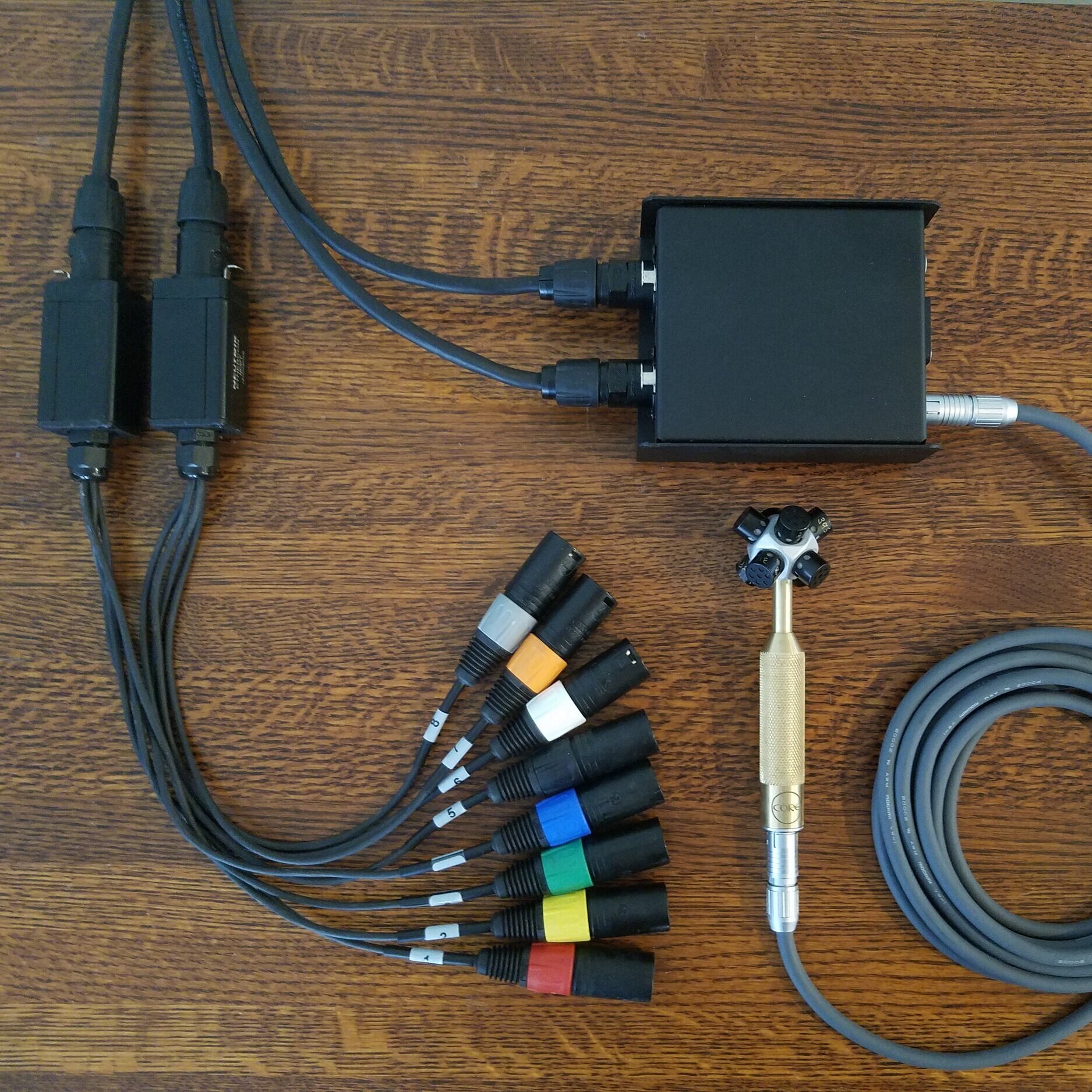Core Sound is pleased to offer its groundbreaking OctoMic.
OctoMic is the world's first 2nd-order ambisonic microphone.
OctoMic is the ideal microphone for recording Virtual Reality (VR) projects, including cinema, video games, music and ambience. In post-production, OctoMic allows users to define arbitrarily complex microphone configurations, and to dynamically track sound sources in space. During playback, it allows for dynamic head-tracking and an unlimited number of playback speaker configurations.
Pair it with a suitable eight-track digital audio recorder, and it's ready to record. We recommend pairing OctoMic with the Sound Devices MixPre-10T or the Zoom F8.
OctoMic offers significant improvements over 1st-order ambisonic microphones. The improvements are particularly attractive for cinema, gaming, music and ambience, for three important reasons:
It is far better at preserving the perceptual cues necessary for a listener to precisely locate sound sources.
It provides a much larger "sweet spot" for listeners. While first-order ambisonic microphones have a "sweet spot" around the size of a human head, OctoMic's "sweet spot" can accommodate multiple listeners without degrading a recording's sound location perceptual cues.
OctoMic can be used 50% farther away from the sound source while maintaining the same directivity index.
Like TetraMic, OctoMic's frequency response is exceedingly flat and extended. Its bass response extends below 30 Hz, and its treble response above 18.5 kHz. Its dynamic range extends from the very quiet of a fine recording studio to the roar of a jet engine at close range. TetraMic's self-noise specification is excellent, but OctoMic improves on it by 3 dB.
Like TetraMic, each OctoMic is individually aligned using a exceedingly effective measurement and calibration procedure. It is delivered with its own unique calibration file. This ensures that all OctoMics are perfectly matched to deliver excellent results. This unique feature allows OctoMic to retain its fine performance over time because it can be recalibrated as it ages. This critical feature is absent in other ambisonic microphones. (We recommend recalibrating OctoMic every two or three years, depending on your application.)
OctoMic's size is another valuable feature. Only slightly larger than the tiny TetraMic, OctoMic is much smaller than any other ambisonic microphone. This is a significant tech advantage because it is much easier to hide during VR360 shooting, and reduces the need to edit out the microphone image in post-production.
OctoMic comes with a VST or AAX plug-in to perform A- to B-format conversion. The plugin outputs standard 9-channel 2nd-order B-format. The output has been tested and confirmed to work with the most popular DAWs and the Facebook 360 Spatial Workstation. The plug-in operates on Windows and Mac PCs. Linux is also supported.
Once in B-format, the recording can be decoded to any number and type of coincident microphones, each oriented in any desired direction and having any desired pickup pattern. OctoMic can function as the world's finest Blumlein array, and when used as an omni microphone, is equal to the world's best, including the DPA 4003 used for calibration.
In addition to modelling any number and type of spatially coincident microphones, OctoMic can model spaced microphone arrays (e.g., ORTF, Decca Tree, Double MS, ORTF-3D, ORTF Surround, Hamasaki Square, Fukada Tree, INA, PCMA-3D) by using more than one OctoMic. Please compare OctoMic's cost and performance excellence to other spaced array solutions.
OctoMic can also act as shotgun microphone that's aimed in post-production!
By using a head motion tracker in your editing suite, OctoMic's recordings can dynamically track a listener's head motions, and present the correct spatial location cues for all sound sources. The apparent orientation can be rotated, tilted, tumbled or zoomed at will.
The nine channels of B-format can also be interpreted into almost any playback format, including:
mono (without "sum to mono" phase cancellation issues)
stereo
binaural, fixed-head or headtracked, using individualized or generic HRTF information
four speakers arranged as a square or rectangle
six speakers arranged as a regular or irregular hexagon
5.1 (ITU)
7.1
10.1
Dolby Atmos
any of the above plus height information (e.g., two hexagonal arrays of speakers, one above the listener and one below)
and many, many more.
Summing up, OctoMic allows your audio projects to have unparalleled flexibility in post-production.
How good a microphone is OctoMic? We believe OctoMic has the flattest and most extended fig-8 response of any commercially available microphone, bar none (including TetraMic); so it's among the best Blumlein arrays in the world. Its free-field omni response is not quite as good as a Bruel & Kjaer 4133 1/2-inch measurement microphone; it's only as good as the wonderful DPA 4003 that we use for calibration -- i.e., sensational! However its diffuse-field response is better than the 4003. This combination of capabilities makes OctoMic one of the world's finest microphones.
Until now, you couldn't buy a 2nd-order ambisonic microphones at any price. Most much less capable 1st-order ambisonic microphones are priced between $2000 and over $20,000. OctoMic is priced under $2000, including its processing software and all hardware, including cables.
OctoMic is more than eight microphone capsules on a precision machined mount. Building an OctoMic starts with a large batch of carefully assembled microphone capsules, pre-selected for sensitivity and frequency response. Each capsule is then exhaustively tested for sensitivity, frequency response, directivity pattern and other parameters. We select eight well-matched capsules and confirm their compatibility. Then another round of exhaustive testing begins, this time for the complete eight capsule assembly. All in all, each OctoMic undergoes more than seven hours of assembly, testing and calibration. Each OctoMic exits the test phase with its own calibration and correction files, used with its A-to-B-format VST encoder plug-in to ensure that each OctoMic is a fine example of one of the best sounding microphones in the world.
ORTF using two OctoMics

































.jpg)


.jpg)














































No comments:
Post a Comment